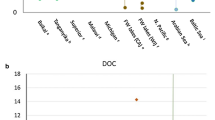Abstract
Polar dissolved organic matter (DOM) was isolated from a surface-water sample from the Great Salt Lake by separating it from colloidal organic matter by membrane dialysis, from less-polar DOM fractions by resin sorbents, and from inorganic salts by a combination of sodium cation exchange followed by precipitation of sodium salts by acetic acid during evaporative concentration. Polar DOM was the most abundant DOM fraction, accounting for 56% of the isolated DOM. Colloidal organic matter was 14C-age dated to be about 100% modern carbon and all of the DOM fractions were 14C-age dated to be between 94 and 95% modern carbon. Average structural models of each DOM fraction were derived that incorporated quantitative elemental and infrared, 13C-NMR, and electrospray/mass spectrometric data. The polar DOM model consisted of open-chain N-acetyl hydroxy carboxylic acids likely derived from N-acetyl heteropolysaccharides that constituted the colloidal organic matter. The less polar DOM fraction models consisted of aliphatic alicyclic ring structures substituted with carboxyl, hydroxyl, ether, ester, and methyl groups. These ring structures had characteristics similar to terpenoid precursors. All DOM fractions in the Great Salt Lake are derived from algae and bacteria that dominate DOM inputs in this lake.
Similar content being viewed by others
References
Alemany L.B., Grant D.M., Pugmire R.J., Alger T.D. and Zilm K.W. 1983. Cross polarization and magic angle sample spinning NMR spectra of model organic compounds: 2. Molecules of low or remote protonation. J. Am. Chem. Soc. 105: 2142–2147.
AWWARF, American Water Works Association Research Foundation 2001. Polar NOM: Characterization, DBP's, Treatment. AWWARF, Denver, CO, pp. 3-1–3-26.
Amon M.W.R. and Benner R. 1996. Bacterial utilization of different size classes of dissolved organic matter. Limnol. Oceanogr. 4: 41–51.
Audrieth L.F. and Kleinberg J. 1953. Non-Aqueous Solvents: Applications as Media for Chemical Reactions, Chapter 8, Acetic Acid. John Wiley and Sons, New York, pp. 148–151.
Benner R., Pakulski J.D., McCarthy M., Hedges J.I. and Hatcher P.G. 1992. Bulk chemical characteristics of dissolved organic matter in the ocean. Science 225: 1561–1564.
Buesseler K.O., Bauer J.E., Chen R.F., Eglinton T.I., Gustafsson O., Landing W., Mopper K., Moran S.B., Santschi P.H., VernonClark R. and Wells M.L. 1996. An intercomparison of cross-flow filtration techniques used for sampling marine colloids: overview and organic carbon results. Mar. Chem. 55: 1–31.
Carlson C.A. and Ducklow H.W. 1995. Dissolved organic carbon in the upper ocean of the central equatorial Pacific Ocean, 1992: daily and fine scale vertical variations. Deep-Sea Res. 42: 639–656.
Davisson M.L. 2002. Isotopic Tracers in Surface Water. American Water Works Association Research Foundation, Denver, CO.
Domagalski J.L., Orem W.H. and Eugster H.P. 1989. Organic geochemistry and brine composition in Great Salt, Mono, and Walker Lakes. Geochim. Cosmochim. Acta 53: 2857–2872.
Doran P.T., Berger G.W., Lyons W.B., Wharton R.A., Davisson M.L., Southon J. and Dibb J.E. 1999. Dating Quaternary lacustrine sediments in the McMurdo Dry Valleys, Antarctica. Paleogeo. Paleoclim. Paleoecol., 147: 223–239.
Druffle E.R.M. and Williams P.M. 1990. Identification of a deep marine source of particulate organic carbon using bomb 14C. Nature 347: 172–174.
Hedges J.I., Ertel J.R., Quay P.D., Grootes P.M., Richey J.E., Devol A.H., Farwell G.W., Schmide F.H. and Salati E. 1986. Organic carbon-14 in the Amazon River system. Science 231: 1129–1131.
Hem J.D. 1970. Study and Interpretation of the Chemical Characteristics of Natural Water. U.S. Geological Survey Water-Supply Paper 1473. 2nd ed., US Geological Survey, Washington, DC.
Huffman Jr. E.W.D. and Stuber H.A. 1985. Analytical methodology for elemental analyses of humic substances. In: Aiken G.R., McKnight D.M., Wershaw R.L. and MacCarthy P. (eds) Humic Substances in Soil, Sediment, and Water: Geochemistry, Isolation, and Characterization. John Wiley and Sons, New York, pp. 433–455.
Leenheer J.A., Croue J.-P., Benjamin M., Korshin G.V., Hwang C.J., Bruchet A. and Aiken G. 2000. Comprehensive isolation of natural organic matter for spectral characterization and reactivity testing. In: Barrett S., Krasner S.W. and Amy G.L. (eds) Natural Organic Matter and Disinfection By-Products. American Chemical Society Symposium Series 761. American Chemical Society, Washington, D.C., pp. 68–83.
Leenheer J.A., Hsu J. and Barber L.B. 2001. Transport and fate of organic wastes in groundwater at the Stringfellow hazardous waste disposal site, southern California. J. Contam. Hydrol. 51: 163–178.
Leenheer J.A., Rostad C.E., Barber L.B., Schroeder R.A., Anders R. and Davisson M. 2001. Nature and chlorine reactivity of organic constitutents from reclaimed water in groundwater, Los Angeles County, California. Environ. Sci. Technol. 35: 3869–3876.
Lehninger A.L., Nelson D.L. and Cox M.M. 1993. Principles of Biochemistry. 2nd edn. Worth Publishers, New York, pp. 315–318.
Raymond P.A. and Bauer J.E. 2001. Use of 14C and 13C natural abundances for evaluating riverine, estuarine, and coastal DOC and POC sources and cycling: a review and synthesis. Org. Geochem. 32: 469–485.
Repeta D.J., Quan T.M., Aluwihare L.I. and Accardi A.M. 2002. Chemical characterization of high molecular weight dissolved organic matter in fresh and marine waters. Geochim. Cosmochim. Acta 66: 955–962.
Santschi P.H., Guo L., Baskaran M., Trumbore S., Southon J., Bianchi T.S., Honeyman B. and Cifuentes L. 1995. Isotopic evidence for the contemporary origin of high-molecular weight organic matter in oceanic environments. Geochim. Cosmochim. Acta 59: 625–631.
Stephens D.W. and Gillespie D.M. 1976. Phytoplankton production in the Great Salt Lake, Utah, and a laboratory study of algal response to enrichment. Limnol. Oceanogr. 21: 74–87.
Stuiver M. and Polach H. 1977. Reporting of 14C data. Radiocarbon 19: 355–363.
Vogel J.S., Southon J.R. and Nelson D.E. 1987. Catalyst and binder effects in the use of filamentous graphite in AMS. Nucl. Instrum. Meth. Phys. Res. B29: 50–56.
Williams P.M. and Druffle E.R.M. 1987. Radiocarbon in dissolved organic matter in the central North Pacific Ocean. Nature 330: 246–248.
Rights and permissions
About this article
Cite this article
Leenheer, J.A., Noyes, T.I., Rostad, C.E. et al. Characterization and origin of polar dissolved organic matter from the Great Salt Lake. Biogeochemistry 69, 125–141 (2004). https://doi.org/10.1023/B:BIOG.0000031044.16410.27
Issue Date:
DOI: https://doi.org/10.1023/B:BIOG.0000031044.16410.27




